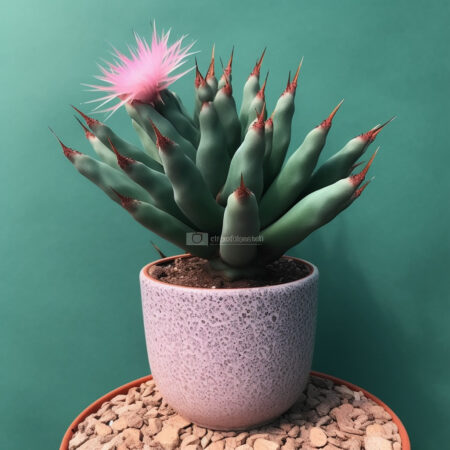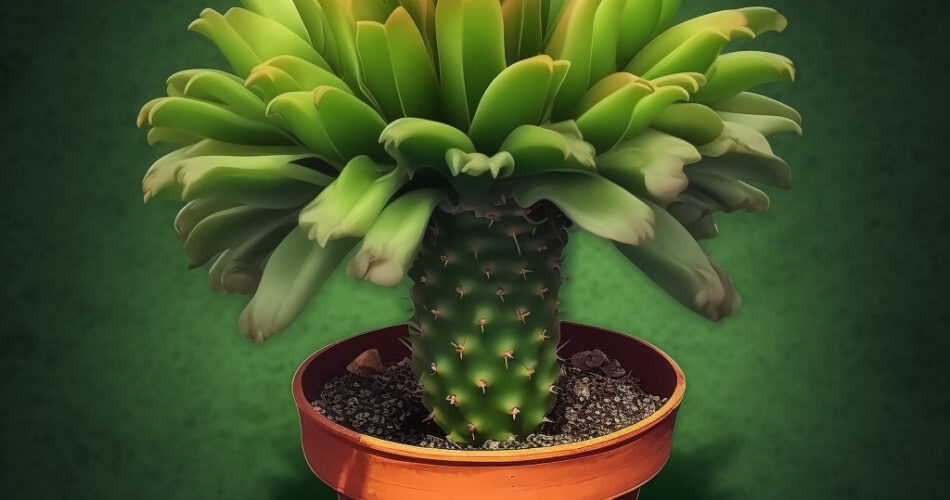Key Takeaways:
- This genus originates from North America’s arid regions and is known for its captivating features.
- Adaptations like deep taproots and a thick, waxy exterior enable these plants to thrive in tough environments.
- Its radiant flowers come in a broad spectrum of colors and designs, enticing various pollinators.
- With over 30 distinct species, this genus offers a vast range of visual appeal and habitat preferences.
- To nurture these plants successfully, it’s vital to ensure optimal growth conditions and keep pests and diseases at bay.
- These cacti can beautifully elevate garden aesthetics, serving as both ornamental pieces and conversation starters.
A Brief Introduction to Thelocactus
Thelocactus is a fascinating genus of cacti that originates from the arid regions of North America. Its name comes from the Greek words “thelo,” meaning papilla or nipple, and “kaktos,” meaning thistle. This unique name perfectly describes the appearance of these plants, which feature cylindrical or globular bodies covered in numerous tubercles with pronounced nipples.
The Fascinating Origins of Thelocactus
Thelocactus is native to the deserts and semi-deserts of Mexico and the southwestern United States. It thrives in areas with well-draining soil and plenty of sunlight. The diverse habitats where it can be found range from rocky hillsides to sandy plains, and even limestone outcrops.
These harsh environments have shaped the unique adaptations. These cacti have developed deep taproots to access water deep in the ground and thick, waxy skins that help reduce water loss through evaporation.
The Unique Characteristics of Thelocactus
Thelocactus is known for its distinct appearance and interesting features. The plants are usually solitary, growing either as small globular or cylindrical shapes. They have numerous tubercles arranged spirally around their bodies, giving them their characteristic nipple-like appearance.
One of the most fascinating features of it is their ability to change color depending on the environmental conditions. They can range from shades of green to pink, purple, or even red. This natural variation adds to their allure and makes them highly sought after by collectors.

The Mesmerizing Beauty of Thelocactus Flowers
Thelocactus produces stunning flowers that are a sight to behold. Despite their small size compared to some other cacti species, these flowers are known for their vibrant colors and intricate patterns.
The Stunning Array of Flower Colors
Thelocactus flowers come in a wide range of colors, from delicate pastels to bold and vibrant hues. The most common colors include shades of pink, purple, red, yellow, and white. Some species even have bi-colored or multi-colored flowers that add to their visual appeal.
The beautiful colors of its flowers are not only visually pleasing but also attract pollinators such as bees and butterflies, which play a crucial role in the plant’s reproductive cycle.
The Intricate Patterns and Forms of Flowers
In addition to their striking colors, Thelocactus flowers showcase intricate patterns and forms that further enhance their beauty. Some species have flowers with concentric rings of petals, while others feature star-like shapes or elongated tubular forms.
These unique flower shapes and patterns have evolved to attract specific pollinators. For example, tubular flowers are often visited by hummingbirds, as their long beaks can reach the nectar hidden deep within.
The Diversity of Thelocactus Species
The genus Thelocactus encompasses a diverse range of species, each with its own unique characteristics and distribution. Exploring the different types of Thelocactus can be a fascinating journey into the world of cacti.
Exploring the Different Types
There are over 30 recognized Thelocactus species, each with its own distinct morphology and habitat preferences. Some notable species include Thelocactus bicolor, Thelocactus hexaedrophorus, and Thelocactus setispinus.
These species vary in size, shape, spine arrangement, and flower color. Some are more cylindrical in shape, while others are globose. Their spines can be long and pronounced or short and stubby, providing additional visual interest.
Understanding the Geographic Distribution
These cactus species can be found across a wide geographical range spanning from Mexico to the southern United States. They are particularly abundant in the states of Texas, Coahuila, and Nuevo Leon in Mexico.
Their distribution is influenced by factors such as climate, soil conditions, and proximity to water sources. Some of its species are endemic to specific regions, making them even more valuable to collectors and cacti enthusiasts.
Cultivating and Caring for Thelocactus Plants
Thelocactus is a popular choice among cacti enthusiasts, thanks to its unique appearance and relatively easy care requirements. By providing the ideal growing conditions and following a few tips and tricks, you can enjoy the beauty of it in your own home or garden.
The Ideal Growing Conditions for Thelocactus
Thelocactus thrives in bright, indirect sunlight, making it suitable for both indoor and outdoor cultivation. It prefers well-draining soil, such as a mix of cactus potting soil and perlite or coarse sand. Adequate drainage is crucial to prevent root rot, a common issue in cacti.
In terms of temperature, it prefers warm to hot conditions, ranging from 70 to 90 degrees Fahrenheit (21 to 32 degrees Celsius). It is important to protect the plants from frost, as they are not tolerant of freezing temperatures.
Tips and Tricks for Successful Care
Providing proper care for Thelocactus involves a few additional considerations. While they are drought-tolerant, they still require regular watering during the growing season. It is important to water deeply, allowing the soil to dry out between waterings to prevent root rot.
Fertilizing it sparingly with a balanced cactus fertilizer can promote healthy growth. However, it is essential not to over-fertilize, as this can lead to burns and damage to the plants.
In addition, it may benefit from occasional repotting to refresh the soil and provide additional space for growth. Repotting should be done carefully to avoid damaging the delicate roots.
Common Pests and Diseases Affecting Thelocactus
Like all plants, Thelocactus is vulnerable to certain pests and diseases. Identifying and addressing these issues promptly is crucial to ensure the health and longevity of your plants.
Identifying and Treating Pest Infestations in Thelocactus
Common pests that can affect Thelocactus include mealybugs, scale insects, and spider mites. These pests can cause damage to the plant’s delicate tissues and lead to stunted growth or even death if left untreated.
If you notice signs of pest infestation, such as webbing, yellowing or wilting of the plant, or the presence of tiny insects, it is important to take action. In mild cases, washing the plant with a gentle soap solution or using neem oil can help control the pests. For severe infestations, it may be necessary to use chemical insecticides, following the instructions carefully.
Preventing and Managing Disease Issues in Thelocactus
Thelocactus can also be susceptible to diseases such as root rot, fungal infections, or bacterial infections. These issues are often caused by overwatering, poor drainage, or unsanitary growing conditions.
To prevent disease, it is essential to provide appropriate watering practices, ensure proper drainage, and maintain a clean growing environment. If disease symptoms appear, such as soft or discolored spots on the plant, it is important to take action promptly. Removing affected parts and treating the plant with a suitable fungicide or bactericide can help control the spread of the disease.
Thelocactus in Landscaping and Design
Thelocactus can be a valuable addition to any garden or landscape design, thanks to its unique appearance and low-maintenance requirements. There are several creative ways to incorporate Thelocactus into your outdoor spaces.
Creative Ideas for Incorporating Thelocactus Into Garden Designs
Thelocactus can be planted in rock gardens, desert-themed gardens, or xeriscapes, where they complement other drought-tolerant plants. Their unique shapes and colors add visual interest and provide a focal point in the landscape.
Grouping different Thelocactus species together can create an eye-catching display that showcases their diversity. Mixing them with other succulents and cacti can further enhance the visual impact.
Using Thelocactus as Focal Points or Statement Plants
Thelocactus’s striking appearance makes it an excellent choice for using as a focal point or statement plant in landscaping. Placing a large specimen of Thelocactus in a prominent location, such as a courtyard or entrance, creates an immediate visual impact.
Thelocactus can also be grown in containers and displayed on patios, decks, or balconies. This allows for easy mobility and the opportunity to appreciate the intricate details of the plants up close.
In conclusion, Thelocactus is a truly captivating genus of cacti that offers a wide range of beauty and diversity. From its fascinating origins to its mesmerizing flowers and diverse species, Thelocactus has much to offer to plant lovers and collectors alike. With proper care and attention, these unique cacti will thrive and continue to bring joy and fascination to anyone who appreciates their splendor.
FAQ
Question: Where do these cacti originate?
Answer: These plants are native to the arid regions of North America, predominantly the deserts and semi-deserts of Mexico and the southwestern United States.
Question: What makes these cacti stand out in terms of appearance?
Answer: They have cylindrical or globular bodies adorned with many tubercles featuring pronounced nipples. Their color can shift based on environmental factors, showcasing hues from green to pink, purple, or even red.
Question: How diverse are the flower colors for these plants?
Answer: Their flowers display a spectrum of shades such as pink, purple, red, yellow, and white, with some species even showcasing bi-colored or multi-colored blooms.
Question: How many varieties exist within this cacti genus?
Answer: The genus comprises over 30 distinct species, each presenting unique attributes. Some well-known species among them include bicolor, hexaedrophorus, and setispinus variants.
Question: What conditions favor their growth?
Answer: These cacti flourish in areas with bright, indirect sunlight, paired with well-draining soil. They’re accustomed to warm or hot climates and don’t fare well under freezing conditions.
Question: Which pests commonly target these cacti?
Answer: Mealybugs, scale insects, and spider mites are among the typical pests these plants might contend with.
Question: Are they prone to any specific diseases?
Answer: They can fall prey to ailments such as root rot, fungal afflictions, or bacterial infections.
Question: How can one incorporate them into landscape designs?
Answer: These cacti are versatile additions to rock gardens, desert-themed layouts, or xeriscapes. They make great statement plants, fit well into container gardening, and can be the highlight in any garden design.




Comments